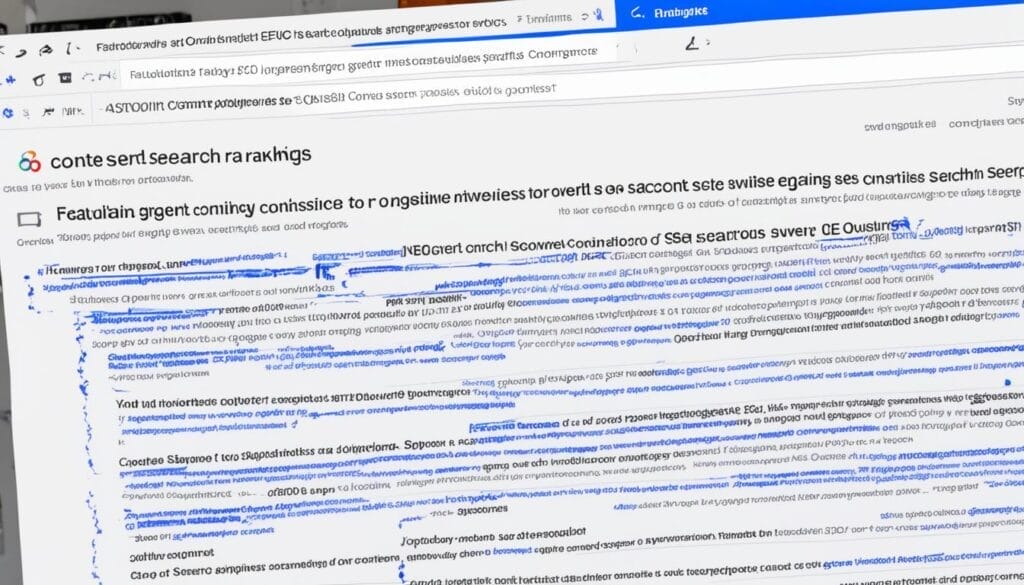In today’s digital world, being on the first page of search results is key. Websites ranked on the first page get 92% of all traffic. If you’re not there, you’re losing out on many visitors. But don’t worry. You can boost your site’s visibility by using smart SEO strategies.
SEO Content Optimisation is about making your site more visible. It combines different methods to help you rank higher. Do thorough keyword research, optimise your website well, and create content that grabs attention. These steps will dramatically improve your SEO performance.
Key Takeaways:
- Being ranked on the first page of search results can lead to a substantial increase in traffic to your website.
- SEO Content Optimisation involves implementing effective strategies to improve your website’s visibility and search engine rankings.
- Thorough keyword research and optimisation are essential for attracting the right audience to your website.
- Creating high-quality, engaging content is crucial for keeping visitors on your site and encouraging them to take further action.
- Consistently monitoring and optimising your SEO strategy is essential for achieving long-term success.
Review Existing Content Before Creating New Content
Before you start making new content, look back at what you have. This step can boost your SEO and cut down on costs. When you find and fix old or unhelpful content, your site stays up-to-date and interesting to your visitors.
Assessing your content’s success is key. Use tools like Google Search Console and Semrush’s Site Audit for this. They help spot crawlability issues and technical glitches, making your site easier for search engines to find and understand.
When reviewing, watch out for topic overlap. Creating too many articles on the same topic can hurt your SEO and confuse your readers.
To get more organic traffic, focus on updating content. Look for pages that are old and refresh them. Update stats, add new examples, or revise outdated info. This enhances their worth.
Reviewing and updating old content before making new stuff is key. It helps your site shine, avoids topic repetition, and saves money. It’s crucial for a strong online image.
Benefits of Reviewing Existing Content:
- Improved SEO: Getting rid of old content makes your site look new. This can make your SEO better.
- Cost Savings: Tweaking existing content saves the cost of making new stuff from zero.
- Enhanced User Experience: Keeping content fresh and relevant makes visitors happier and more informed.
Keeping your content updated is an ongoing task. By doing so regularly, your website will always seem new and relevant. This is great for keeping a solid online presence and boosting your SEO over time.
Structure Your Content for Featured Snippets
Want to get your website noticed more? Try aiming for featured snippets. These are the top search results that instantly answer user questions. Having your site in this spot increases visibility greatly.
First, focus on finding the right keywords. You can use tools like Semrush’s Keyword Magic Tool to discover what questions pull up snippets. Then, write your content based on these keywords to boost your chances of being featured.
It’s also important to structure your content well. Use tags like H2s and H3s to lay out your information clearly. By doing this, you make it easier for search engines to understand and highlight the key parts of your content.
Making your main point right at the start can help too. This method is called BLUF (Bottom Line Up Front). It gives users quick answers and may help your content become a featured snippet.
Don’t forget about using the right HTML tags to show what’s important in your content. Adding image alt tags and catchy meta descriptions also helps. These steps can make your content more likely to end up as a featured snippet.
Key Steps to Optimise Content for Featured Snippets:
- Perform comprehensive keyword research using tools like Semrush’s Keyword Magic Tool to find questions that lead to snippets.
- Structure your content effectively with tags like H2s and H3s for clear layout.
- Start with the most important point using the BLUF method for quick, clear answers.
- Utilise relevant image alt tags and write compelling meta descriptions.
By sticking to these steps and always working to improve your content, you can increase your odds of being in featured snippets. This can draw more viewers to your site.
| Pros of Structuring Content for Featured Snippets | Cons of Structuring Content for Featured Snippets |
|---|---|
| Increased visibility in search engine results. | No guarantee of being featured as a snippet. |
| Establishes your website as a reliable source of information. | Can lead to decreased click-through rates for some users. |
| Provides an instant answer to users’ queries. | Requires ongoing optimisation and content refinement. |

Create New Content Based on Low-Competition Keywords
Improving your website’s SEO starts with targeting low-competition keywords. These kinds of keywords are easier to rank for. They can bring more organic traffic to your site. Question keywords are a great example, as they are specific and not too competitive.
Finding question keywords can be easy with the right tools. The Keyword Magic Tool is one option. Looking at “People also ask” in Google search results is another good strategy. This can show you what people are curious about in your field.
Long-tail keywords are another key focus. Even though they get fewer searches, they’re very specific. They cover a large part of internet searches. Using these keywords can bring more targeted visitors to your site.
Before using low-competition keywords, look at keyword difficulty and search intent. Keyword difficulty shows how tough it is to rank for a keyword. Search intent is why someone makes a specific search. Understanding these helps you pick the right keywords for your audience.
Low-competition keywords, like question and long-tail keywords, enhance your content strategy. They can help your site rank better and bring in more organic traffic.
Benefits of Targeting Low-Competition Keywords
Low-competition keywords have many advantages, including:
- Higher chances of ranking: You’re more likely to rank well and get more organic traffic.
- Targeted audience: Such keywords draw in a more specific audience looking for what you offer.
- Less expensive: They cost less in paid ads compared to competitive keywords.
“By targeting low-competition keywords, you can tap into untapped potential and attract valuable organic traffic to your website.”
– Paul Nightingale, SEO Pro
Using low-competition keywords is a wise SEO tactic. With thorough research and content optimisation, your site’s visibility and traffic can soar.
| Keyword | Search Volume | Keyword Difficulty |
|---|---|---|
| Low-competition keywords | 880 | 45 |
| Question keywords | 590 | 35 |
| Long-tail keywords | 720 | 40 |
Build Quality Backlinks for SEO
Building quality backlinks boosts your website’s SEO. They’re like endorsements from relevant, respected sites. This can greatly improve your search engine ranking.
Focus on making content everyone wants to share. This draws backlinks from niche blogs and news sites. Link building means getting links from other sites to yours. These links act as paths driving traffic back to you. They show search engines your content matters.
Creating data-driven content that tells a story is key. Doing research and sharing data pulls in interest. It draws links from big sources.
Using Help a Reporter Out (HARO) by Connectively is another trick. It connects you with reporters who need expert quotes. Give them great insights, and when they use your input, you get backlinks. It’s a chance to show you know your stuff and get noticed in your industry.
It’s important to follow Google’s spam policies. Don’t buy links or use shady schemes. Build real backlinks through top content and real connections with industry folks.
Tools like Semrush’s Link Building Tool make finding backlink opportunities easier. It shows you relevant websites and tracks your backlink progress. You can spot good link partners, check their importance, and see how well they fit with your work.
Key Points:
- Building quality backlinks is crucial for improving SEO.
- Backlinks from relevant and highly regarded sites act as endorsements and boost search engine rankings.
- Create shareable content that attracts backlinks from blogs and news sites.
- Develop data-driven content to provide unique insights and attract links.
- Contribute to journalists’ queries through Help a Reporter Out for potential backlinks.
- Adhere to Google’s spam policies and avoid engaging in prohibited practices.
- Utilise Semrush’s Link Building Tool to streamline the process of finding link building prospects.
By actively building quality backlinks, you up your site’s authority. This makes you more visible online. And it takes your SEO to the next level.

Insert Useful Images and Optimise Them Effectively
Image optimisation is key for better SEO. It makes your site look good and can bring more visitors. To help your SEO, make sure your images are optimised right.
1. Reduce Image File Size:
Big images make your site slow, which is bad for SEO and user experience. Compress images to keep their quality. You can use online tools or editing software for this.
2. Choose the Right Image Format:
Picking the right format can speed up your site. JPEG or PNG are good choices. They load fast and meet your needs based on the image.
3. Provide Descriptive Image Descriptions:
Always add alt text to your images. Alt text is a short description for search engines. Use keywords in your alt text to boost SEO and help those who can’t see the images.
4. Ensure Image Relevancy:
Use images that fit your content. They should add to the text and look good. This makes your content more impactful and engaging.
5. Mobile-Friendliness:
With more people using mobiles, your images must work on all devices. They should adjust to any screen size. This makes sure everyone has a good experience, no matter the device.
By following these tips, your content looks better, your site works better, and your SEO can improve. See the example below for tips on image optimisation:
| Before Image Optimisation | After Image Optimisation |
|---|---|
 |  |
Let's Sum Up...
SEO Content Optimisation is crucial for your website’s visibility and search engine rankings. You can do many things to improve, like review and enhance current content. Also, aim for the featured snippets, use less-competitive keywords, get quality backlinks, and optimise images.
It’s important to keep your content updated. This helps a lot with your website’s SEO performance.
Keeping an eye on your content and enhancing it is vital to stay competitive online. Stay current with SEO trends and always improve your content. This will bring more visitors to your site and boost your success chances.
Remember, SEO is a continuous effort that needs dedication. By putting in time and resources into SEO Content Optimisation, you boost your site’s visibility. This attracts more visitors, improves your search engine rankings, and enhances your online presence.
FAQ
What is SEO content optimisation?
SEO content optimisation makes your site more visible and rank higher on search engines. It includes using SEO strategies, researching keywords, and making your content more appealing. This aims to get more people visiting your site organically.
Why is SEO content optimisation important?
This optimisation is key for higher search engine rankings and visibility. Optimised content brings more visitors, boosts your site’s credibility, and drives conversions. It’s essential for successful online presence.
What is the difference between on-page SEO and off-page SEO?
On-page SEO focuses on your site’s own elements like keywords and content structure. Off-page SEO uses external strategies such as link building and social media marketing. Both aim to boost your site’s visibility and credibility.
How can I conduct keyword research for my content?
For keyword research, Semrush’s Keyword Magic Tool is useful. It provides keyword options and their popularity. Also, check the “People also ask” section in Google for specific question keywords.
How can I structure my content for featured snippets?
Structure your content with clear HTML tags for featured snippets. Start with the main points first, using the BLUF method. This approach helps search engines pick up your content for snippets.
What are low-competition keywords, and why are they important?
Low-competition keywords are specific and less contested. They’re key for drawing in targeted organic traffic. Focusing on these can boost your rankings and make your content more visible to the right audience.
How can I build quality backlinks for my website?
For quality backlinks, create content that others want to link to. Leverage data to tell stories that appeal. Offer your expertise on platforms like Help a Reporter Out. Semrush’s Link Building Tool can also guide your backlink efforts.
How does image optimisation affect SEO?
Image optimisation enhances SEO by speeding up your site and providing search engine clues. Use reduced file sizes and descriptive alt text for images. Properly optimised images also make your site more appealing and user-friendly.





